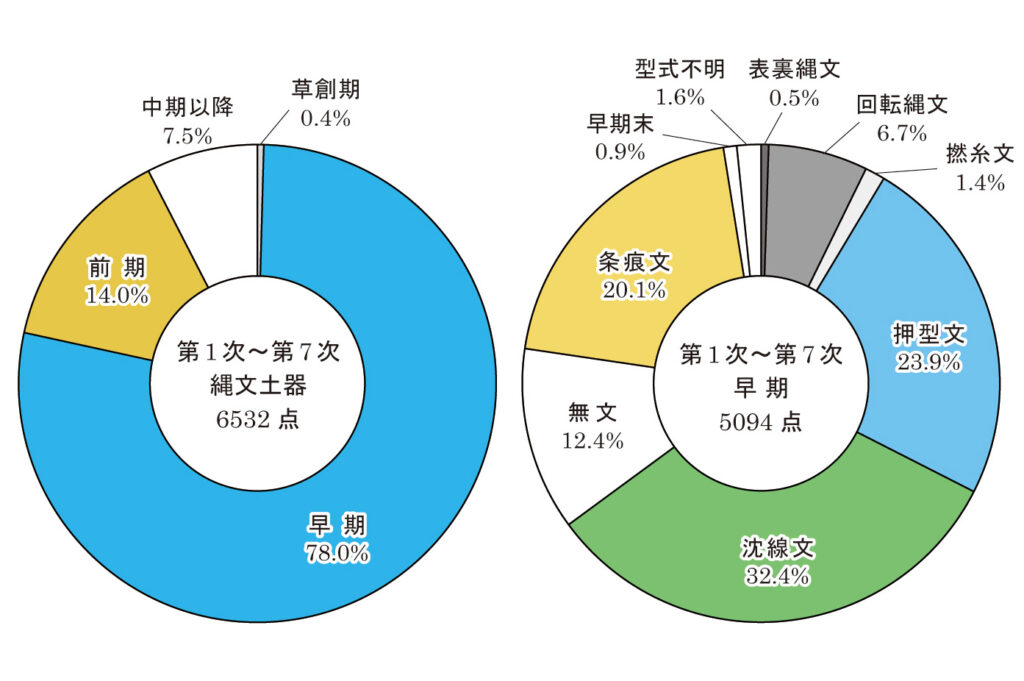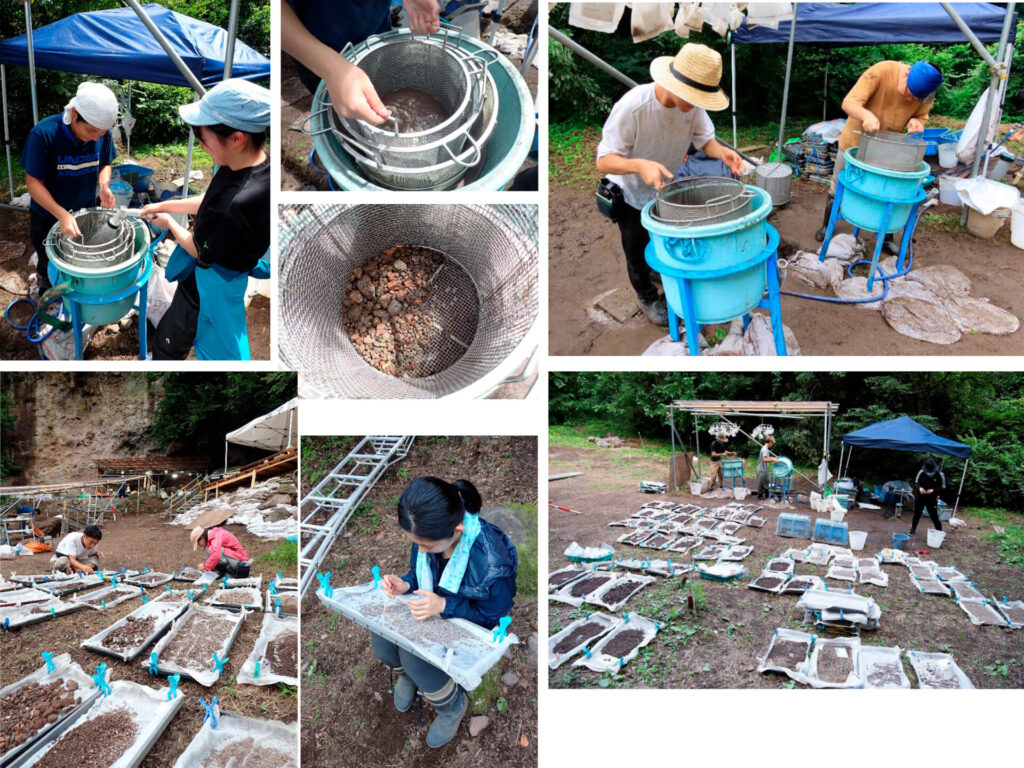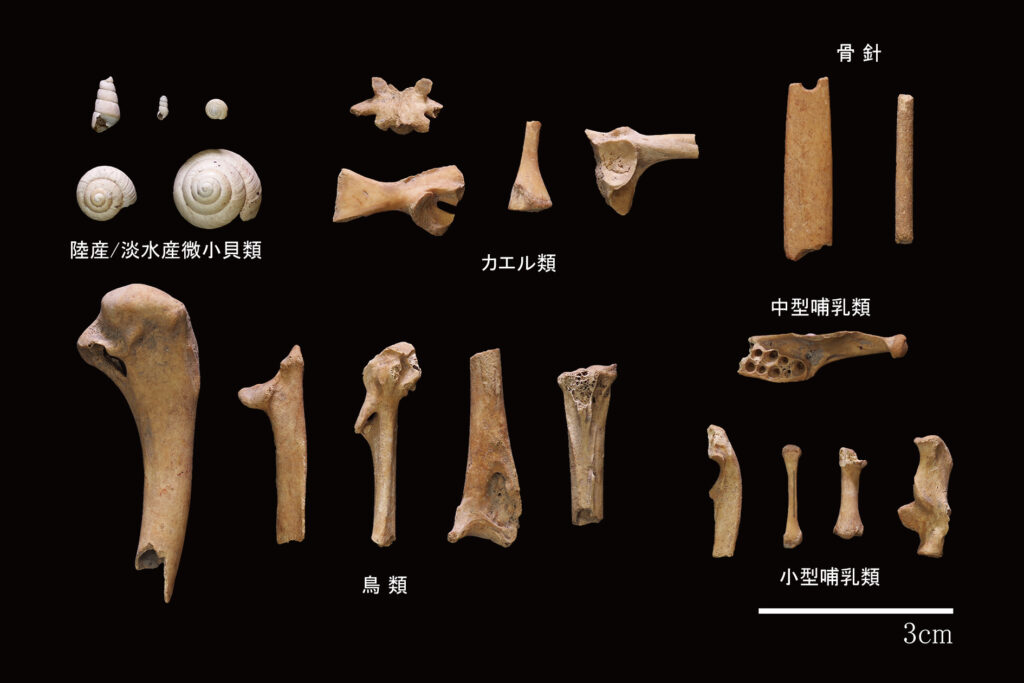Reconstructing Life during the Initial Jomon Period
Changes in Site Formation
Of the pottery assemblages excavated to date, the majority date to the Initial Jomon period. The amounts of Oshigatamon and Chinsenmon pottery from the middle part of the Initial Jomon period and Jokonmon pottery from the latter part of the Initial Jomon period are particularly large (Fig. 1).
The largest number of artifacts were discovered during the Oshigatamon phase (dating to the middle part of the Initial Jomon period), along with a large ash deposit and discarded animal bones, suggesting that the rock shelter was used as a base camp for hunting activities. The dominance of stone arrowheads among the excavated stone tools is also indicative of hunting activities (Fig. 2).
Fig. 1 Initial Jomon period pottery excavated from the Iyai site
Fig. 2 Jomon-period stone tools excavated from the Iyai site
In the following Chinsenmon phase, traces of activity accompanied by the formation of ash deposits were also observed, but the formation pattern was different from that of the Oshigatamon phase, consisting of thin alternating layers of ash, charcoal, and sand and gravel. It is possible that between the Oshigatamonon and Chinsenmon phases there were changes in the behaviour of the population and the use of rock shelters, in conjunction with the change in the pottery type.
During the Jokonmon phase (dating to the latter part of the Initial Jomon period), the usage of rock shelter changed, and its interior became primarily used as burial ground, with large quantities of human skeletal remains buried in dense concentrations. As for the pottery assemblages dating to after the Initial Jomon period, there were relatively large quantities of Kaitenmonjomon pottery (dating to the first half of the Early Jomon period) and Moroiso style pottery (dating to the latter half of the Early Jomon period). A small number of human skeletal remains dating to the Early Jomon Period have also been recovered, but the frequency of rock shelter use diminished, and the ash deposits virtually became non-existent in the second half of the Early Jomon period. There are traces of intermittent use of the rock shelter in the latter half of the Middle Jomon period (in the form of Kasori E and Goudo pottery), the first half of the Late Jomon period (in the form of Horinouchi pottery), the latter half of the Final Jomon period (in the form of Fusen-amijomon pottery) and the Yayoi period, but the quantities of artifacts are small.
Utilisation of Plant and Animal Resources during the Initial Jomon Period
Artifacts, including minute fragments, and animal and plant remains, were recovered from an artificial ash deposit formed approximately 10,000 years ago during the Oshigatamon phase (middle part of the Initial Jomon period) by means of soil sieving (dry sieving, water separation, and flotation). These materials were analysed using zooarchaeological and archaeobotanical techniques to investigate the resource utilisation, subsistence activities and diet of the Initial Jomon period populations (Figs. 3 and 4).
Fig. 4 Animal bone and horn implements recovered by water separation
(left: excavated from inside the rock shelter, right: excavated from terrace area, 8th Investigation)
Plant seeds have been identified by their phytomorphological species using stereomicroscopy and scanning electron microscopy, and the role of plant resources in the diet of the Initial Jomon people is being explored. In addition, we are also discovering plant seed impressions preserved on Initial Jomon period pottery. The identification of the carbonised seeds suggests that hard fruits of the genus Castanea (chestnut) and Quercus (oak) and the Juglans ailantifolia (Japanese walnut) were frequently consumed, but we have also discovered that in addition, the populations had begun utilizing wild species that would subsequently be cultivated, such as a millet, soybean and azuki.
As for the animal remains, the analysis of material excavated up to the fifth excavation has identified 24 species of terrestrial, freshwater and saltwater shellfish, one species of freshwater crab, four species of freshwater fish, three species of frogs, three species of snakes, seven species of birds, and 22 species of mammal. The fauna consists mainly of native sika deer, wild boar, pheasants, and other small to medium-sized terrestrial animals. Many of the bones of the main game species, sika deer and wild boar, bear butchery marks and it is believed that they were systematically exploited for food, leather and as raw material for the manufacture of bone and antler implements. In addition, a variety of other animal species, including small animals such as frogs and rodents, are known to have been exploited. On the other hand, the quantities of fish bones excavated were extremely small and only rarely found during the sorting of minute artefacts recovered through soil sieving. Despite the use of the freshwater peal mussel and mussel species, fishing activity in the river was low. Twelve species of terrestrial micromolluscs have been identified, including the cockatoo mussel and the brown mussel. These are useful for reconstructing the landscape during the time of the site’s formation.
Marine shell and shark-tooth ornaments have also been found in connection with burials from the Jokonmon phase. Beads made of cone shells and horn shells are also frequently found. The fossilised tusk shell is estimated to have come from the Miura Peninsula in Kanagawa Prefecture.
Ecological Activity During the Initial Jomon Period
In order to investigate the behavioural domains of the Initial Jomon period populations, the origins of the obsidian material were estimated by X-ray fluorescence analysis. It was found that the majority of the obsidian from throughout the various periods was from Kofukazawa (Wadatoge series) and Hoshigatou (Suwa series). This indicates that the territory of the populations inhabiting the site extended to the area surrounding an obsidian production centre more than 60km away.
The behavioural patterns of the Initial Jomon populations and the temporal changes in the formation of the site are also becoming clearer. During the Oshigatamon phase (dating to the middle part of the Initial Jomon period), there are traces of activity in the form of large ash deposits, indicating that hunting activities were actively carried out using the rock shelter as a base camp. Analysis of the styles and clays used for the Oshigatamon pottery, as well as the source of the obsidian, suggests that the populations travelled to and from areas in Nagano Prefecture. In the following Chinsenmon phase, however, the ash deposits become less frequent, the pottery types become more localised, and the amount of animal bone excavated decreases. During the latter part of the Initial Jomon Period, the arrival of Tsukinoki-kaso style pottery from the Tohoku region and Nojima and Ugajimadai style pottery from the southern Kanto region coincided with the use of the rock shelter as a burial ground, and evidence of exchange with the coastal areas of the southern Kanto region was seen in the artifacts brought in, including horn shells and mussel beads. These changes in site formation are thought to be related to a long-term shift from an inland mountain subsistence pattern, highly dependent on hunting, to an open plains subsistence pattern, as evidenced by the shell middens formed during the Holocene glacial retreat.。
Yasuhiro Taniguchi








